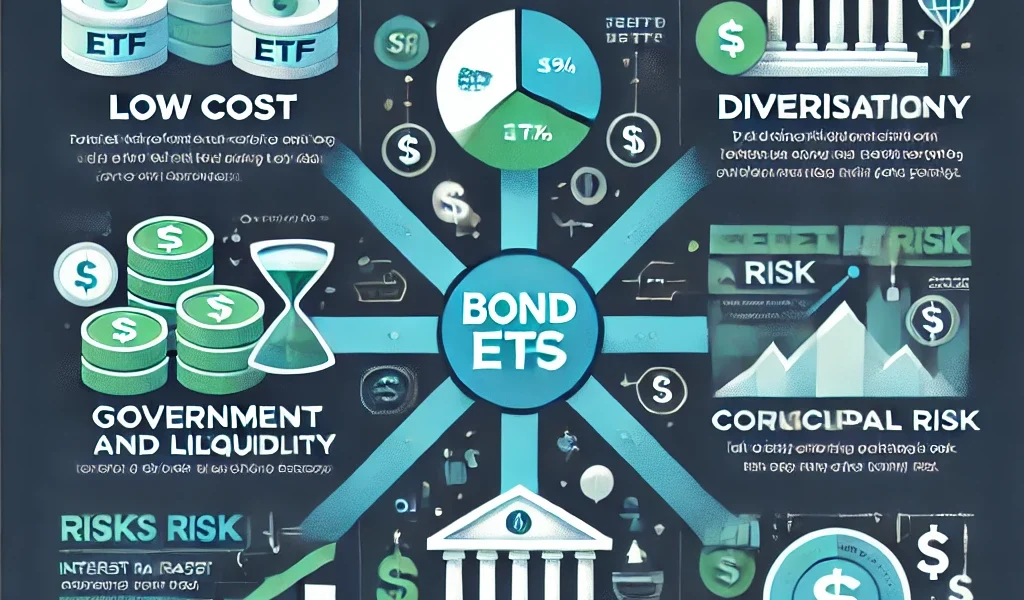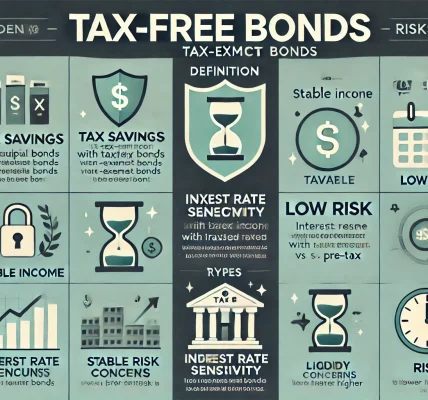As financial markets evolve, investors are continually seeking cost-effective and diversified ways to manage their portfolios. One of the most efficient methods to achieve this is by investing in Bond Exchange-Traded Funds (ETFs). Bond ETFs provide exposure to a broad range of fixed-income securities, offering both diversification and liquidity at a lower cost compared to traditional bond investments.
This comprehensive guide explores the structure, benefits, risks, and tax implications of bond ETFs and explains how they can help investors achieve a well-balanced portfolio.
🎯 What Are Bond ETFs?
💡 Definition of Bond ETFs
A Bond ETF (Exchange-Traded Fund) is a type of investment fund that holds a diversified portfolio of bonds and trades on a stock exchange, just like a stock. Bond ETFs aim to replicate the performance of a specific bond index, providing investors with exposure to different types of bonds, including government, corporate, municipal, and international bonds.
📝 How Bond ETFs Work
- Purchasing Bonds: Bond ETFs purchase a basket of bonds that mirror the composition of an underlying bond index.
- Trading Like Stocks: Unlike traditional mutual funds, bond ETFs trade on major exchanges and can be bought and sold throughout the trading day.
- Price Fluctuations: The price of a bond ETF fluctuates based on supply and demand, but the fund’s net asset value (NAV) is derived from the value of the underlying bonds.
📊 Types of Bond ETFs
1️⃣ Government Bond ETFs
- Invest in bonds issued by governments such as U.S. Treasury bonds, providing low-risk, stable returns.
- Example: iShares U.S. Treasury Bond ETF (GOVT)
2️⃣ Corporate Bond ETFs
- Focus on bonds issued by corporations with varying credit quality, offering higher yields than government bonds.
- Example: iShares iBoxx Investment Grade Corporate Bond ETF (LQD)
3️⃣ Municipal Bond ETFs
- Invest in bonds issued by states, municipalities, and local governments, offering tax-exempt interest income.
- Example: iShares National Muni Bond ETF (MUB)
4️⃣ High-Yield (Junk) Bond ETFs
- Invest in lower-rated, high-yield bonds with higher default risk but higher potential returns.
- Example: SPDR Bloomberg High Yield Bond ETF (JNK)
5️⃣ International Bond ETFs
- Provide exposure to bonds issued by foreign governments and corporations, diversifying geographical risk.
- Example: iShares International Treasury Bond ETF (IGOV)
✅ Benefits of Investing in Bond ETFs
📈 1. Diversification
Bond ETFs provide exposure to a broad range of fixed-income securities, reducing portfolio risk by spreading investments across different issuers and sectors.
💸 2. Lower Costs and Fees
Bond ETFs typically have lower expense ratios than actively managed bond mutual funds, making them a cost-effective investment option.
🔄 3. Liquidity and Flexibility
Unlike traditional bond funds, bond ETFs trade on exchanges throughout the day, allowing investors to buy and sell shares at market prices.
🛡️ 4. Transparency
Bond ETFs provide full transparency regarding their holdings, enabling investors to assess the fund’s composition and risk exposure.
📊 5. Tax Efficiency
Bond ETFs are generally more tax-efficient than mutual funds, as they generate fewer capital gains distributions.
❗ Risks Associated with Bond ETFs
📉 1. Interest Rate Risk
When interest rates rise, bond prices fall, which can negatively impact the value of bond ETFs, especially those with longer durations.
🔄 2. Credit Risk
Bond ETFs that invest in corporate or high-yield bonds face the risk of issuer default, which can lead to a decline in the value of the ETF.
📊 3. Liquidity Risk
While bond ETFs are typically liquid, periods of market stress may lead to wider bid-ask spreads and reduced liquidity.
💸 4. Tracking Error
Bond ETFs aim to replicate the performance of an underlying index but may experience tracking errors due to management fees, rebalancing costs, or imperfect replication.
📊 Comparing Bond ETFs to Traditional Bonds and Mutual Funds
| Feature | Bond ETFs | Individual Bonds | Bond Mutual Funds |
|---|---|---|---|
| Diversification | High | Low (single issuer) | High |
| Liquidity | High (trades like stocks) | Low (illiquid secondary market) | Moderate |
| Expense Ratio | Low | No direct fees | Higher expense ratios |
| Interest Payments | Monthly or quarterly | Semi-annual | Monthly or quarterly |
| Flexibility | High | Low | Moderate |
| Transparency | High | Moderate | Lower |
🧠 How to Choose the Right Bond ETF for Your Portfolio
🎯 1. Define Your Investment Goals
Consider whether you’re investing for income, capital preservation, or portfolio diversification.
🔎 2. Assess Your Risk Tolerance
Evaluate your willingness to accept interest rate and credit risk. Government bond ETFs offer lower risk, while high-yield bond ETFs provide higher returns with greater volatility.
📊 3. Consider Duration and Yield
Duration measures the sensitivity of bond ETFs to interest rate changes. Longer-duration ETFs are more sensitive to rate changes, while shorter-duration ETFs offer stability.
📉 4. Analyze Credit Quality
Review the credit ratings of the bonds in the ETF’s portfolio to ensure they align with your risk tolerance.
💸 5. Evaluate Expense Ratios and Fees
Lower expense ratios enhance long-term returns. Compare expense ratios across different bond ETFs before making an investment decision.
💡 Tax Implications of Bond ETFs
✅ 1. Tax Treatment of Interest Income
- Interest income from government bond ETFs is subject to federal tax but may be exempt from state and local taxes.
- Interest income from municipal bond ETFs is typically exempt from federal taxes and may be exempt from state taxes if issued by the investor’s home state.
💸 2. Capital Gains Taxes
Bond ETFs may generate capital gains when the underlying bonds are sold or when investors sell their ETF shares. Capital gains are subject to federal and state capital gains taxes.
📉 3. Tax Efficiency of Bond ETFs
Bond ETFs are generally more tax-efficient than traditional bond mutual funds due to their creation and redemption mechanism, which minimizes capital gains distributions.
📊 Strategies for Using Bond ETFs in Your Portfolio
📈 1. Income Generation
Bond ETFs that invest in high-yield or corporate bonds can generate a steady stream of income, making them suitable for income-focused investors.
🛡️ 2. Capital Preservation
Government and investment-grade bond ETFs provide stability and capital preservation, making them ideal for conservative investors.
🔄 3. Diversification of Risk
Combining different types of bond ETFs (government, corporate, and international) can help diversify portfolio risk and improve returns.
📉 4. Hedging Against Market Volatility
Bond ETFs can serve as a hedge against stock market volatility by providing stability and reducing overall portfolio risk.
⚖️ Legal Considerations for Bond ETFs
⚠️ 1. Avoid Misleading Yield Comparisons
Ensure that any discussion about bond ETF yields clearly distinguishes between SEC yield and distribution yield to avoid misleading comparisons.
⚠️ 2. Disclose Risks Clearly
Highlight the risks associated with bond ETFs, including interest rate risk, credit risk, and liquidity concerns.
⚠️ 3. Provide General Educational Information
Ensure that the content remains educational and avoids personalized investment advice to comply with regulatory guidelines.
📊 Summary: Key Takeaways
- Bond ETFs offer a low-cost, diversified way to invest in fixed-income securities with the flexibility of trading like stocks.
- They provide liquidity, transparency, and tax efficiency, making them an attractive choice for a wide range of investors.
- Understanding the types of bond ETFs, their risks, and tax implications is essential for maximizing returns and achieving portfolio diversification.
- Investors should evaluate expense ratios, credit quality, and interest rate sensitivity when selecting bond ETFs to align with their investment goals.




